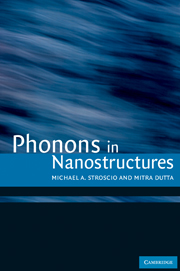Book contents
- Frontmatter
- Contents
- Preface
- Chapter 1 Phonons in nanostructures
- Chapter 2 Phonons in bulk cubic crystals
- Chapter 3 Phonons in bulk würtzite crystal
- Chapter 4 Raman properties of bulk phonons
- Chapter 5 Occupation number representation
- Chapter 6 Anharmonic coupling of phonons
- Chapter 7 Continuum models for phonons
- Chapter 8 Carrier–LO-phonon scattering
- Chapter 9 Carrier–acoustic-phonon scattering
- Chapter 10 Recent developments
- Chapter 11 Concluding considerations
- Appendices
- References
- Index
Chapter 1 - Phonons in nanostructures
Published online by Cambridge University Press: 09 October 2009
- Frontmatter
- Contents
- Preface
- Chapter 1 Phonons in nanostructures
- Chapter 2 Phonons in bulk cubic crystals
- Chapter 3 Phonons in bulk würtzite crystal
- Chapter 4 Raman properties of bulk phonons
- Chapter 5 Occupation number representation
- Chapter 6 Anharmonic coupling of phonons
- Chapter 7 Continuum models for phonons
- Chapter 8 Carrier–LO-phonon scattering
- Chapter 9 Carrier–acoustic-phonon scattering
- Chapter 10 Recent developments
- Chapter 11 Concluding considerations
- Appendices
- References
- Index
Summary
There are no such things as applied sciences, only applications of sciences.
Louis Pasteur, 1872Phonon effects: fundamental limits on carrier mobilities and dynamical processes
The importance of phonons and their interactions in bulk materials is well known to those working in the fields of solid-state physics, solid-state electronics, optoelectronics, heat transport, quantum electronics, and superconductivity.
As an example, carrier mobilities and dynamical processes in polar semiconductors, such as gallium arsenide, are in many cases determined by the interaction of longitudinal optical (LO) phonons with charge carriers. Consider carrier transport in gallium arsenide. For gallium arsenide crystals with low densities of impurities and defects, steady state electron velocities in the presence of an external electric field are determined predominantly by the rate at which the electrons emit LO phonons. More specifically, an electron in such a polar semiconductor will accelerate in response to the external electric field until the electron's energy is large enough for the electron to emit an LO phonon. When the electron's energy reaches the threshold for LO phonon emission – 36 meV in the case of gallium arsenide – there is a significant probability that it will emit an LO phonon as a result of its interaction with LO phonons. Of course, the electron will continue to gain energy from the electric field.
In the steady state, the processes of electron energy loss by LO phonon emission and electron energy gain from the electric field will come into balance and the electron will propagate through the semiconductor with a velocity known as the saturation velocity.
- Type
- Chapter
- Information
- Phonons in Nanostructures , pp. 1 - 5Publisher: Cambridge University PressPrint publication year: 2001
- 2
- Cited by



